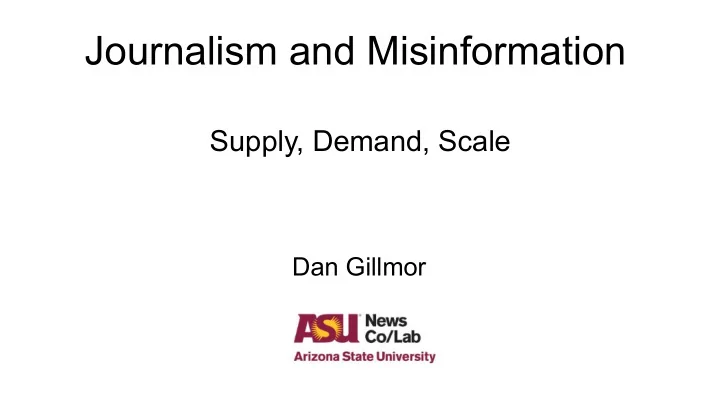

Journalism and Misinformation Supply, Demand, Scale Dan Gillmor
Situation ● Too much misinformation comes from traditional media. ● Journalism is an attack surface—and part of the solution. ● Media literacy—the demand side—is vital.
Obligatory reminder...
This isn’t new.
Current conditions in journalism ● Amplifiers for deceit ● Often unaware of being used ○ Inadequate detection and response ● 24-hour news cycle => 1,400-minute news cycle ● Major financial challenges
Among journalism’s pretenses: ● Our work speaks for itself. ● We got the whole story. ● If we ever covered it, you have the context. ● Even though breaking news is inherently flawed, trust us anyway.
Hypothesis: People get more misinfo from traditional media than social media* *This needs serious research!
“ The most worrisome misinformation in U.S. politics remains the old-fashioned kind: false and misleading statements made by elected officials who dominate news coverage and wield the powers of government. ” --Brendan Nyhan, Dartmouth College
But this is new (or at least recent): The disinformation-technical-political-industrial complex.
Source: First Draft
And it will get much, much worse...
Journalism is a key attack surface.
Deceitful people: ● Hack journalistic norms ○ “Both sides” ● Provide ratings/clickbait catnip ($$$) ○ e.g. Trump in 2015-16 ● Trick news orgs into running outright BS ○ e.g. scientific “studies” paid for by vested interests ● Leverage technology and networks to promote false memes ○ “It’s out there.”
Hacking journalistic norms It’s raining. It’s not raining. Democrats say it’s raining. Republicans disagree.
"It May Not Be Good for America, but It's Damn Good for CBS" -- Les Moonves, CBS CEO (February, 2016)
“...web of conspiracy theorists, Russian operatives, Trump campaigners and Twitter bots who manufactured the ‘news’ that Hillary Clinton ran a pizza-restaurant child-sex ring.”
Journalists need to: ● Understand how they’re being used ○ Don’t chase the latest shiny objects ● Rethink some traditional norms ○ ...such as amplifying falsehoods ● Learn math/statistics ○ Put risk in context ● Fill “data voids” with trustworthy info ● And that’s just for starters...
But no mention of news Yes!!!! (and entertainment) media’s role in fueling fear...
Caution: The “ Do Something!” Brigades
Do what, exactly?
We can’t just upgrade supply. We have to upgrade us . At scale.
One way to help improve demand: media/news literacy It needs journalism’s help. (And yours…)
Media Literacy Media literacy: The ability to access, analyze, evaluate, create and act on media messages in all forms. News literacy: Applying these critical thinking News Literacy skills in the context of news information. *Consuming and creating media with integrity is key “News fluency”
Part of a combination of related “literacies” ● Information ● Digital ● Media ● News ● Network ● plus ● Data (math, stats, etc.) ● Science ● and more...
Improving demand: Who’s responsible? How do we make it scale?
Educators at all levels Wikimedia Commons, ASU/edX
Media—including news organizations Wikimedia Commons, Pixabay
Technology companies Pixabay
Collaborate.
newscollab.org dan@gillmor.com @dangillmor dangillmor.com
Recommend
More recommend